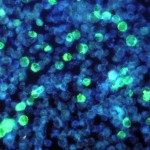Link to Pubmed [PMID] – 11836415
J. Virol. 2002 Mar;76(5):2375-83
An acute infection with lymphocytic choriomeningitis virus (LCMV) is efficiently controlled by the cytotoxic-T-cell (CTL) response of the host, and LCMV titers in the spleen and peripheral solid organs usually fall sharply after day 4 to 6 postinfection. Surprisingly, infection of immunodeficient recombination-activating gene 2-deficient (RAG2-/-) mice with 5 x 10(2) PFU of LCMV-WE causes about 80-fold-lower LCMV titers in the spleen on day 4 postinfection compared with C57BL/6 control mice. This could not be attributed to NK cell activity, since common gamma-chain-deficient RAG2-/- mice lacking NK cells show low LCMV titers comparable to those for RAG2-/- mice. Furthermore, the reduced early LCMV production in spleens could not be explained by an enhanced gamma interferon production in RAG2-/- mice. Analysis of mutant mice exhibiting various defects in the splenic microarchitecture, including (i) tumor necrosis factor alpha-negative (TNF-alpha-/-), lymphotoxin alpha-negative (LTalpha-/-), B-cell-deficient muMT mice, (ii) immunoglobulin M-negative mice, and (iii) RAG2-/- mice reconstituted with wild-type versus TNF-alpha-/- LTalpha-/- B cells, revealed a clear correlation between an intact splenic marginal zone, rapid early replication of LCMV in the spleen, and efficient CTL induction. These results suggest that by the preferential infection of the highly organized splenic microarchitecture, LCMV seems to successfully exploit one of the key elements in the chain of the adaptive immune system. Not only does the early tropism of LCMV for the splenic marginal zone trigger a potent immune response, but at the same time the marginal zone may also become a target of early CTL-mediated immunopathology that impairs immune responsiveness.

